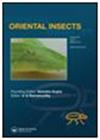新寄主植物记录,自然寄生首次报道,“寄生性保护”行为报告(Hampson, 1892)(昆虫纲:鳞翅目:刺槐科)
IF 0.6
4区 农林科学
Q4 ENTOMOLOGY
引用次数: 0
摘要
摘要/ ABSTRACT摘要:于2021年6 - 9月在印度卡纳塔克邦Chikaballapura地区新记录寄主植物Cissus quadrangularis Linnaeus, 1767 (Vitaceae)上采集到绿绿Thyrassia virescens (Hampson, 1892)幼虫。在室内条件下饲养幼虫,研究其生命周期。幼虫期为18 ~ 22 d,共4龄。蛹期为10-12天。本文首次报道了绿茧蜂寄生在绿茧蜂幼虫上的情况。第一代未发生寄生,第二代和第三代寄生率分别为93.3%和18.18%。关于识别特征的说明,如男性和女性生殖器已被描述。一种有趣的“寄生性保护”行为被记录下来,在这种行为中,毛毛虫似乎保护寄生性茧免受超寄生性和其他敌人的侵害,直到寄生性成虫出现。本文章由计算机程序翻译,如有差异,请以英文原文为准。
New host plant record, first report of natural parasitisation, report of ‘parasitoid guarding’ behaviour with notes on biology and identification of Thyrassia virescens (Hampson, 1892) (Insecta: Lepidoptera: Zygaenidae)
ABSTRACT Caterpillars of Thyrassia virescens (Hampson, 1892) were collected from a newly recorded host plant Cissus quadrangularis Linnaeus, 1767 (Vitaceae) in Chikaballapura district of Karnataka State in India from June to September 2021. Larvae were reared in room condition to study the life cycle. The total larval period was found to be 18–22 days with four instars. The pupal period was found to be 10–12 days. Parasitisation by Cotesia sp. (Braconidae: Hymenoptera) on the caterpillars of T. virescens has been documented for the first time. While there was no parasitisation occurred during the first generation, the second and third generations showed 93.3% and 18.18% parasitisation respectively. Notes on the identification features such as the male and female genitalia have been described. An interesting ‘parasitoid-guarding’ behaviour has been documented, in which the caterpillars seem to protect the parasitoid cocoon from hyper-parasitoids and other enemies until the emergence of parasitoid adult.
求助全文
通过发布文献求助,成功后即可免费获取论文全文。
去求助
来源期刊

Oriental Insects
生物-昆虫学
CiteScore
1.60
自引率
0.00%
发文量
34
审稿时长
>12 weeks
期刊介绍:
Oriental Insects is an international, peer-reviewed journal devoted to the publication of original research articles and reviews on the taxonomy, ecology, biodiversity and evolution of insects and other land arthropods of the Old World and Australia. Manuscripts referring to Africa, Australia and Oceania are highly welcomed. Research papers covering the study of behaviour, conservation, forensic and medical entomology, urban entomology and pest control are encouraged, provided that the research has relevance to Old World or Australian entomofauna. Precedence will be given to more general manuscripts (e.g. revisions of higher taxa, papers with combined methodologies or referring to larger geographic units). Descriptive manuscripts should refer to more than a single species and contain more general results or discussion (e.g. determination keys, biological or ecological data etc.). Laboratory works without zoogeographic or taxonomic reference to the scope of the journal will not be accepted.
 求助内容:
求助内容: 应助结果提醒方式:
应助结果提醒方式:


